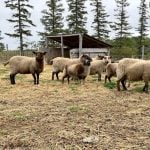LINDELL BEACH, B.C. – Scientists have found that transferring a specific gene from a wild plant into disease- susceptible crops helps make them more resistant to infections.
The researchers transferred the EFR gene from the wild brassicacea weed thale cress to tomatoes, potatoes and a wild tobacco plant originally from Australia that is often used in research because it is susceptible to many viruses and is an ideal study plant for disease resistance.
Plants protect themselves by recognizing invaders and activating their immunity when they detect a microbe. This happens when the EFR gene, which is a pattern-recognition receptor (PRR), detects microbes by recognizing pathogen-associated molecular patterns.
Read Also

Internet of Things tapped for better emissions insights
Interconnected field sensor fleet allows better soil monitoring coverage and, hopefully, live insights on farm greenhouse gas emissions and nitrogen fertilizer application for farms.
Recognition of these microbes triggers a series of defence reactions to arrest the pathogen’s growth. For instance, in the thale cress, EFR contributes to the recognition of crown gall disease.
The researchers were able to show that EFR retained its PRR abilities to recognize microbes after being transferred from the thale cress to the tomato, potato and Australian tobacco, which made them more resistant to a range of bacteria.
The EFR gene transfer technology poses no health hazard, said Cyril Zipfel of Britain’s Sainsbury Laboratory, who worked on the project with Dutch, French and American researchers.
Writing in the journalNature Biotechnology, he said it is already present in crops such as cabbage, cauliflower and broccoli, while another PRR known as FLS2 is also present in most plants.
The success of the controlled laboratory experiment has shown the potential for plants to be more tough and durable in the field, even when confronted by pathogens that have mutated to dodge recognition.
“There are very rare cases when successful pathogens have evolved mutations that allow them to evade recognition,” Zipfel said.
“Another virulence used by pathogens is suppression of defence by secreted virulence factors. However, to our surprise, and delight, the virulence factors secreted by the pathogens that we tested did not seem to be able to suppress EFR function. This confirms our initial working hypothesis that pathogens that are adapted to certain host plants do not have the arsenal to defeat receptors that they have never encountered before.”
However, Zipfel said pathogens can come up with a counter strategy to circumvent just about every strategy to fight disease.
“We need to keep this in mind,” he said. “We are currently trying to identify new receptors that could be combined with EFR to increase the durability of the conferred resistance.”
The researchers are talking with the International Potato Center, which is experimenting with potatoes, sweet potatoes and other tuber crops as part of an effort to reduce poverty and achieve food security in developing countries.
“They are interested in trying the technology in controlled laboratory conditions,” Zipfel said.
“The potato in developing countries suffers a lot from bacterial infection such as the ones triggered by (plant soil bacterium) ralstonia solanacearum. There are currently no good conventional ways to control these soil-borne diseases that can be (so) devastating.”
The research team is also trying to determine if EFR can work in cereals, apples, cassava and bananas, which can be severely affected by bacteria.
Future research will increase the number of pathogens that could be recognized by PRRs by identifying new PRRs and generating PRRs that could recognize a wider range of pathogens.
Ultimately, several PRRs could be introduced simultaneously in plants to build resistance against multiple pathogens and continue to increase resistance in the field.














